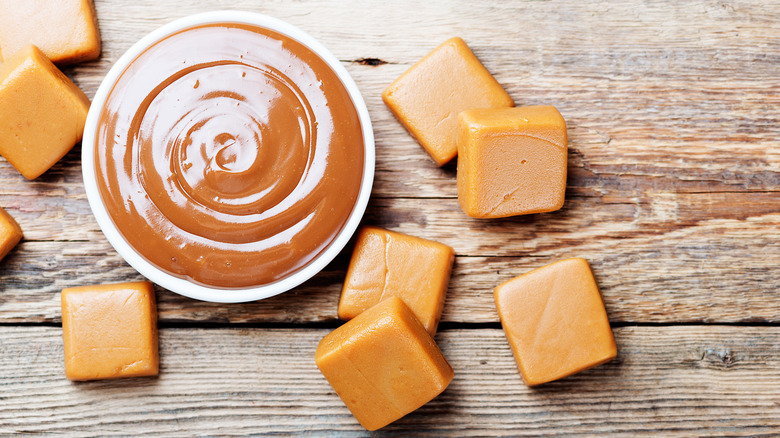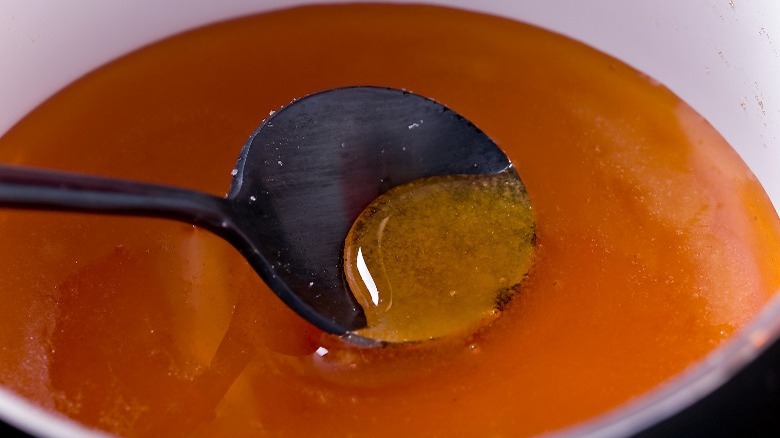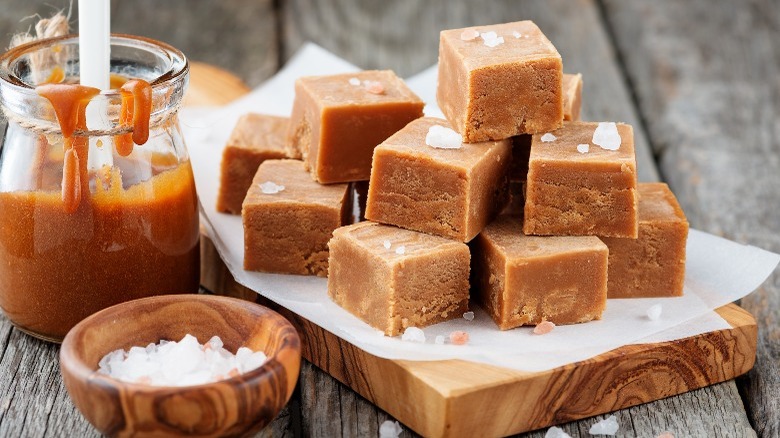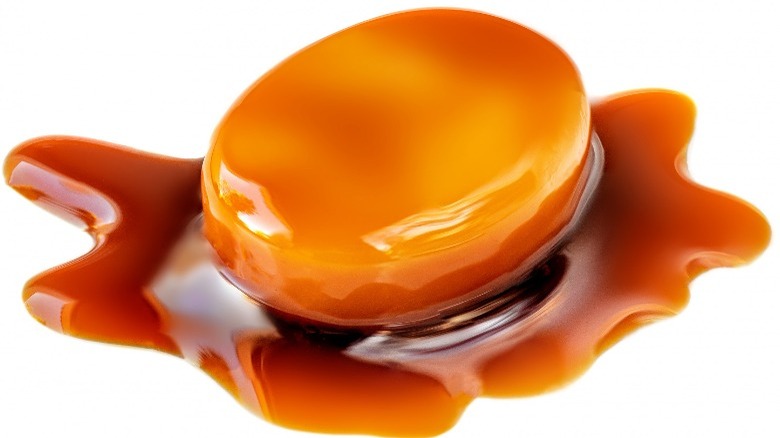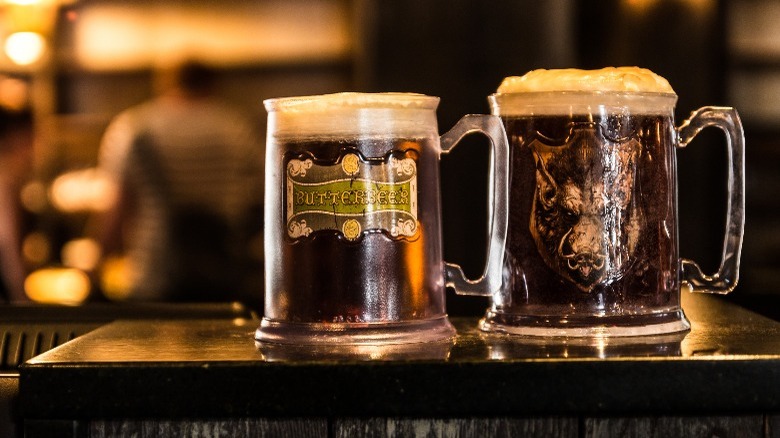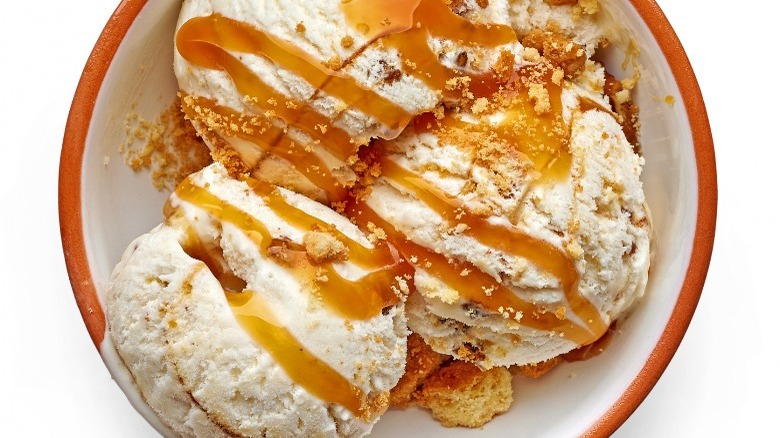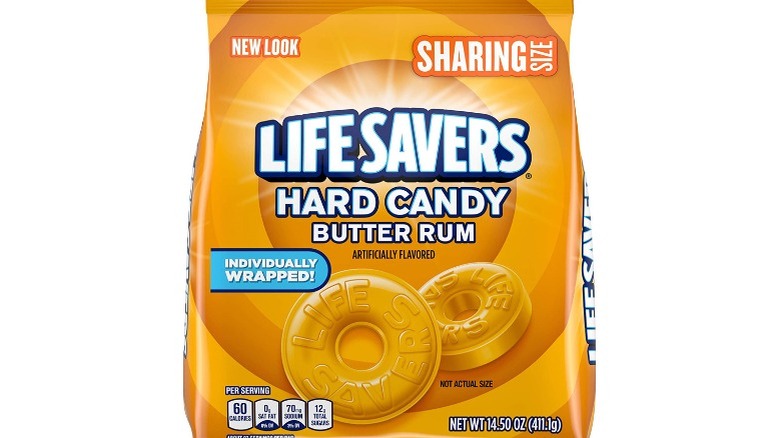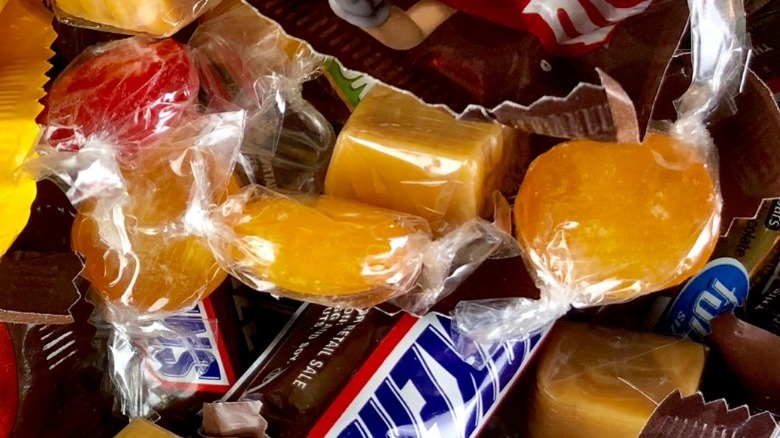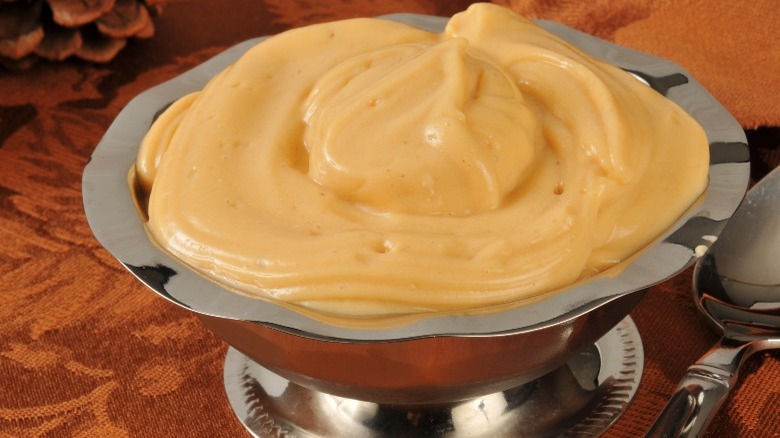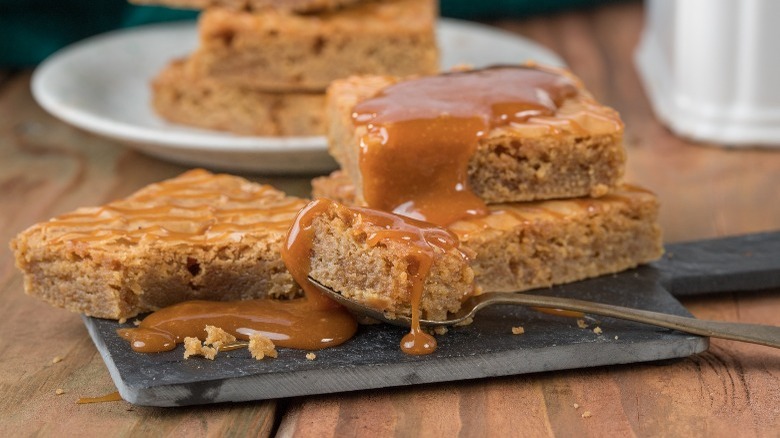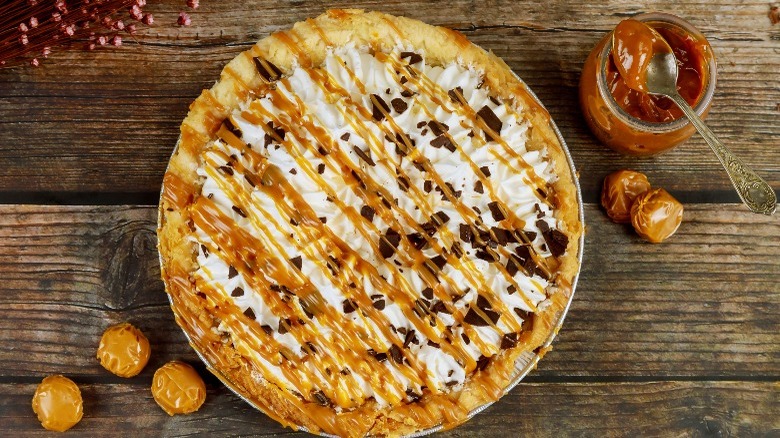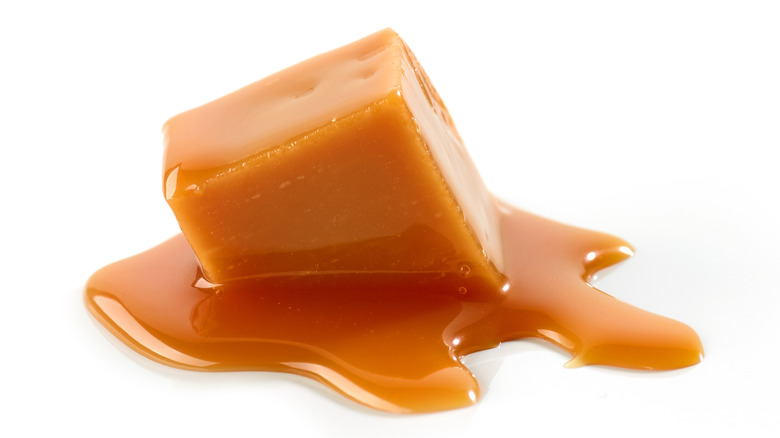The Untold Truth Of Butterscotch
We may receive a commission on purchases made from links.
Butterscotch is an old-fashioned candy flavor that seems to have been around forever, cycling in and out of popularity through the years. In a world of dark chocolate, sea salt caramel and cookies and cream, butterscotch remains a taste on the fringe, an oft-overlooked classic pushed aside in favor of flashier favorites. Ask anyone what butterscotch tastes like, though, and they're likely to have a happy nostalgic memory to share about how butterscotch factored into their childhood. Whether through pudding cups tucked into a lunch box, a dipped cone at the ice cream shop or a roll of Life Savers shared with a friend, the butterscotch experience has had a lasting influence on the world of confections and candy. It even has its own day of appreciation: February 15, for anyone hoping to celebrate.
So what's the real deal with this syrupy confection? Is it only a candy, or does the word "scotch" in the name suggest an alcoholic element somewhere in its history? And how do modern wizards and their beloved butterbeer fit into the equation? With a continent-hopping heritage that stretches back for more than two centuries, there's a lot to unpack in the legacy of this humble candy.
To get to the bottom of the butterscotch story, we dug deep into the candy dish to find a few nuggets of sugary truth about this unassuming old-fashioned confection that always stays in its lane while never losing its place in our hearts.
Butterscotch was invented in England
The world has England to thank for adding butterscotch to the food world over 200 years ago. Credit for the invention of butterscotch goes to one Samuel Parkinson, who had originally created and marketed it as a creation called "buttery brittle toffee" in 1817 Doncaster in Yorkshire, England. At one point, the company received the Royal Seal of Approval and was presented to none other than Queen Victoria in 1851 during a visit to Doncaster. Production of Parkinson's Butterscotch called it quits in 1977 and the very origins of butterscotch were relegated to the dustbin of classic candy history.
In 2003, the discovery of the original recipe in a tin in the cellar of a Doncaster businessman returned the magic formula to the world, and fans rejoiced to have a fresh take on the original butterscotch to enjoy. Confectioners in England picked up where Parkinson left off and are using his recipe to this day, though it looks greatly different from the butterscotch we've come to know and mostly love. Judging by the quintessential hardness of butterscotch candy, it wouldn't surprise us if some of the original pieces from 1817 could still be found at the bottom of grandmothers' purses and crystal candy dishes to this day.
Butterscotch, caramel and toffee are all different
Sure, they may seem interchangeable, and yes, they're made of similar ingredients, but butterscotch, caramel, and toffee are all entirely different concoctions. So what, then, is the difference between butterscotch and caramel? The recipe for genuine butterscotch uses brown sugar, while caramel uses granulated white sugar. It may be a subtle distinction that non-confectioners aren't terribly concerned about, but the resulting products create entirely different flavors and represent two separate revenue streams — an important factor when it comes to candy sales.
The difference between butterscotch and toffee is even subtler. Both recipes use the same ingredients; butterscotch happens to be cooked to the soft-crack stage, around 225 degrees Fahrenheit. Toffee is cooked to the hard-crack stage, of around 300 degrees Fahrenheit. This may seem odd, since butterscotch is most familiar in the golden gem form of a butterscotch disc and toffee is often enjoyed in a chewy, taffy-like form. Even Werther's hard caramels make it difficult to discern, having the flavor of caramel and the texture of butterscotch. But die-hard fans of each know what's what, and that's all that matters at the candy counter.
The origins of the name "butterscotch" are murky
Why is it called "butterscotch"? Did the name originate from the word "scotch," to cut or score, since the hard candy needs scoring before being broken into pieces? Or was it derived from the word "scortch," referring to the process used to create the candy? Or is it a reference to Scotland, where its creation has been mistakenly accredited? There's no definitive proof for any of these. And the long-dead inventor Mr. Parkinson who bestowed the name left no clues. Whichever origin story for the name is true, scotch bourbon has never been an ingredient, so that theory is entirely false.
It's worth noting that Butterscotch has entered the lexicon of baby names. Between 2009 and 2013, Butterscotch was included as a low-ranking possibility for a girl's name. There's no telling how frequently it was used, but the lack of souvenir keychains in airport gift shops bearing the name "Butterscotch" would indicate that it didn't catch on like Bella or Kaitlyn. It ranks much higher as a name for a puppy.
Harry Potter made butterscotch-flavored drinks popular
Butterscotch is more than just candy. It's also been a popular beverage flavor through the years. There are recipes for literally dozens of butterscotch drinks, something to cover every occasion and taste, from eggnog to Jell-O shots. But the magical butterbeer beverage featured in the wildly popular Harry Potter books and movies reinvigorated the popularity of butterscotch. This super sweet carbonated treat is served at the Wizarding World theme park at Universal Studios, providing an added element for people eager to experience the Harry Potter-verse in all its delicious dimensions.
For those who can't make it to Hogwarts for a sip, there's Flying Cauldron, a Virgil's root beer cream soda variant that bottles the butterbeer-style goodness for home consumption. Butterscotch coffee syrups let coffee lovers add a splash of sweet nostalgia to their lattes and mochaccinos. And of course, there's butterscotch schnapps, which brings the sugary, buttery flavor to an adult audience hankering for something that tastes like a shot of melted candy with a kick.
Butterscotch is a classic ice cream topping
Butterscotch and ice cream have enjoyed a sweet little romance through the years, a connection that continues to this day. Ice cream brands from Breyers to Ben & Jerry's have featured butterscotch in their creamy concoctions. Fast food restaurants have introduced butterscotch milkshakes to wild acclaim from a grateful audience. It's been a popular flavor at Dairy Queen for dipped cones and the signature Dilly Bar, a creation invented by a Minnesota woman that featured butterscotch coating from the get-go.
It's also enjoyed popularity as a beloved topping on homemade ice cream sundaes thanks to Smuckers, a bow-tie-and-straw-hat brand name from yesteryear that brings to mind visions of soda fountains serving up a menu's worth of old-fashioned treats. The Smuckers folks have found a way to keep butterscotch sauce on store shelves. For butterscotch connoisseurs, there are always homestyle recipes available for recreating the treacly goodness from scratch. Making it yourself may be a little less convenient than grabbing a jar at the corner grocery store, but hey — at least you can control the sweetness.
Butter Rum Life Savers are not butterscotch Life Savers
Though Life Savers Butter Rum is a beloved stand-in for butterscotch, it isn't exactly butterscotch. It's a take on a buttered rum drink that adds spice to a butterscotch-based flavor. Hot buttered rum became popular in Colonial America, when rum was brought to the colonies from the Caribbean.
It experienced a bigger boom in the early 1940s as a popular tiki drink at Trader Vic's. While it isn't the butterscotch we've all come to know and love, it stands as an early ancestor that set the stage for Life Savers to capture the enchantment in a non-alcoholic candy butterscotch lovers could carry around in their pockets. So what about actual butterscotch Life Savers? It seems like a natural extension, considering butter rum's popularity. Well, there's word around the internet that butterscotch Life Savers were sold in the U.S. and Canada, including photos of the label, but there are no identifiable sources for current sales of the candy. Was it just a rumor? A wish? A figment of the collective imagination of the internet? The world may never know.
Butterscotch discs dominate the hard candy world
Bright orange butterscotch discs wrapped in nuclear yellow cellophane may be the most familiar form of butterscotch candies for most of us. They've held space in mixed hard candy blends for decades, from big-time confectioner brands like Brach's, as well as generic brands. They always appear in the same form, no matter who makes them. These glowing buttons of buttery goodness have found their way to hostess stands in restaurants, candy bowls at Grandma's house, and in trick-or-treat bags of unlucky kids for decades.
If butterscotch in hard candy form has been around for more than two centuries, why has it not shown up in more cosmopolitan forms? It's not for lack of trying on the part of candy industry. In 1996, Hershey's introduced both butterscotch and caramel versions of the short-lived TasteTations hard candies, along with chocolate and mint-chocolate versions. And butterscotch is the most popular flavor of lollipop sold by See's Candies, accounting for nearly 15 million of the pops the company produces annually. Still, for the most readily available butterscotch experience, the vibrant little discs are impossible to escape and instantly recognize whether people like them or not.
Did butterscotch pudding disappear from store shelves?
Butterscotch pudding even has its own appreciation day, separate from the candy. Clearly, people still love this cherished dessert. But could there a parallel universe where butterscotch pudding mix disappeared from store shelves? According to internet lore, the popular pudding flavor went AWOL as a boxed mix, sending butterscotch pudding lovers on a wild goose chase for their favorite treat. While it remained available in the form of handy lunchbox-sized pudding cups, the Jell-O instant and cook-and-sever versions seem to have slid off the menu for a while.
Why the disappearance? According to John Wright, author of "Flavor Creation," butterscotch never even cracked the Jell-O pudding flavors' top 10 list. So it's highly possible that Kraft Heinz, Jell-O's parent company, cleared out the butterscotch to make room for exciting new flavors. Quantum catastrophe or not, boxes of Jell-O butterscotch pudding mix have made an auspicious return! Both instant and cook-and-serve versions are readily available online and in grocery stores once again ... in this dimension, at least. The rest of the multiverse has yet to weigh in.
Butterscotch chips are a popular alternative to chocolate chips
If you love a candy flavor as much as people have loved butterscotch through the years, eventually it will find its way into a cookie flavor. As a companion to their popular Toll House chocolate chips, Nestlé created butterscotch chips and introduced them for sale in 1960. They quickly became popular for including in cookies and confections, like haystacks and Rice Krispie treats. There were even dedicated recipes created to put butterscotch chips on the map. Treats like oatmeal scotchies, scotcheroos, and butterscotch drops were named for their use of butterscotch chips.
The highly-sweet pieces are also regularly included in blondies, the Nestlé Toll House pan cookie predecessor to the classic brownie. Once they gained footing in the homemade sweets and treats world, their popularity grew. Butterscotch had finally found a place in the flavor world beyond ice cream parlors and candy stores! Having caught on in such a big way, butterscotch chips are now created by various food companies, enough to have their own category on Amazon.
Fender and Chrysler use butterscotch-colored paint
Butterscotch's distinctive hue — the more traditional butter-and-brown-sugar version, not the electric ocher version — can be described in food terms; it's a bit more golden than caramel and lighter than toffee, which makes it a unique shade for all sorts of items. From floor coverings to upholstery to appliances, butterscotch in one shade or another has found its way into the color culture zeitgeist.
A few examples: the color "butterscotch blonde" is rock and roll enough to be listed on the Fender guitar color palette. It's a Valspar paint hue that can bring sunshine and lollipops to even the gloomiest room in your house. Pantone, the proprietors of color trends, have a butterscotch shade in their paintbox, too. It was a Chrysler car color for a very limited time between 1969 and 1971, fitting in with the goldenrod-avocado-tangerine color scheme that was popular in that era. There's even a call for butterscotch as a hair color that looks suspiciously similar to golden blonde. No matter what you find in the world with this distinctive color, a simple mention of the word "butterscotch" is enough for anyone to draw a mental picture of this candy's trademark hue.
Butterscotch pie was invented accidentally
Butterscotch desserts can really sneak up on you. Take Sarah Wheeler of Indiana, for instance. In 1904, while baking a custard pie, she burned her ingredients and accidentally invented butterscotch pie. The result was a hit with her sons, who recognized the resulting flavor as butterscotch. It became a popular dessert choice for patrons at a restaurant called Wheeler's Lunch, opened by one of the sons in 1920. When the restaurant closed, the recipe for the pie began circulating and lived on long past the diner.
A simple Google search will return a trove of possibilities for making your own butterscotch pie at home, each version having its own delicious twist. The easiest of these uses a pre-baked pie shell filled with butterscotch pudding and topped with whipped cream. If that sounds like more work than necessary, Sara Lee has a deep dish butterscotch and apple pudding dessert that looks suspiciously like a pie without a crust. And for lovers of high-end, high-calorie desserts, Hershey's has created a recipe for butterscotch cheesecake topped with chocolate drizzle that looks like it should be on everyone's bucket list.
Butterscotch is in the Guinness Book of World Records
It may not be the oldest candy in the world, but butterscotch does hold the distinction of being the largest candy ever created. A giant butterscotch confected in Norway on August 12, 1997, entered into the Guinness Book of World Records as the Largest Candy Ever Created, a record that most likely didn't exist prior. It was a 5' x 5' square enlarged version of the original candies created by Smorbukk that weighed in at a whopping 1,600 kilograms, or 3,527 pounds.
Though the Smorbukk company's current confectionary line is described as "caramels," the record books list the enormous creation as "butterscotch," giving this historical sweet a record-holding status no other candy can claim. It just goes to show that even if you aren't the most popular candy flavor ever created, you can still achieve great things. And yes, the Norwegian version of butterscotch does indeed use the same eye-scorching yellow color in their packaging. Some things never change, no matter how big you get.
